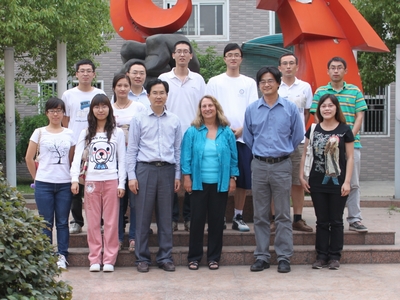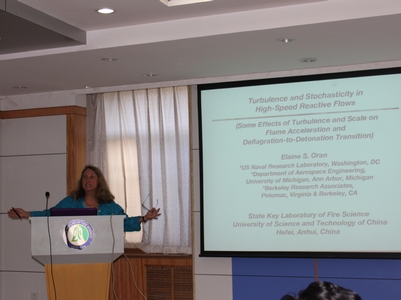应孙金华教授的邀请,国际著名学者、美国海军研究实验室资深科学家Elaine S. Oran教授来火灾科学国家重点实验室进行为期数日的学术交流和访问。5月22日,Oran教授作题为《Turbulence and Stochasticity in High-Speed Reactive Flows》的学术报告。报告针对大系统燃烧极限、火焰加速机理、爆燃到爆轰的突变(DDT)和超新星DDT现象做了详细的介绍和讨论。在随后的问答环节,实验室师生还就关心的内容与Oran教授进行了广泛而深入的交流。在Oran教授的访问期间,还与火灾科学国家重点实验室的相关课题组进行了专题讨论和交流,并就如何开展“极端条件下反应流的基础问题研究”的国际科技合作进行了深入讨论。


Oran教授1972获得耶鲁大学工程与应用科学系博士学位,随后进入美国海军研究实验室工作,并长期致力于计算物理、流体力学和反应流的研究。在PRL,JFM,C&F, AIAA等国际著名期刊发表论文数百篇,撰写《Numerical Simulation of Reactive Flow》等学术著作多部。
Oran教授是美国工程院院士、美国物理学会会士、美国航空航天学会会士,并曾经担任多个国际著名期刊主编、副主编(AIAA Journal等);同时还担任密歇根大学兼职教授、利兹大学客座教授以及威尔士大学荣誉教授。Oran教授获得过多项国际荣誉和奖励,包括美国总统奖、终身成就奖、阿瑟弗莱明奖、燃烧学会泽尔多维奇金奖等,并入选WITI名人堂。
附件:学术报告通知
报告题目:Turbulence and Stochasticity in High-Speed Reactive Flows
报 告 人:Elaine S. Oran(美国工程院院士)
报告时间:May. 22 9:30-10:30
报告地点:火灾新楼2楼多媒体会议室
报告摘要:
There have been many discussions of turbulence and the fact that it is a stochastic process. There have been significantly fewer discussions of what this means in a practical sense of predictability and the consequences for risk assessment. Now we have begun to address these issues as they arise in energetic reactive flows, in which there are multiple interacting stochastic processes, including flow instabilities, turbulence, many interactions between shocks, flames, and vortices, and the resulting formation of ignition centers (hot spots).
The flow that allows us to focus on these issues is the evolution of an initially laminar flame a background medium that may be either quiescent or turbulent. In the first case, we consider a flame propagating down a channel filled with a quiescent, energetic gas and a series of obstacles. As this system evolves, it undergoes flow transitions from subsonic to supersonic, as it simultaneously undergoes transitions among combustion states from a laminar to a violent turbulent flame, and then possibly to the strongest form of combustion, a detonation. This sequence of events and transitions, taken both separately and together, are critical elements of systems ranging from engines to accidental fuel explosions. The second case, where the laminar flame is embedded in a turbulent medium with no solid barriers and no nearby walls, also might occur in accidental explosions or in high-speed engines. In addition, it is important for addressing a fundamental problem in astrophysics: How and why does a deflagration in a type Ia supernova (SNIa) transition to a detonation?
This presentation is illustrated visually by movies made from results of multidimensional, compressible, unsteady, deterministic solutions of the Navier-Stokes equations. In the process of analyzing the dynamic events portrayed in the movie, we have found several surprising properties of the evolving nonequilibrium, non-Kolmogorov turbulence as well as a mechanism for detonations to arise in SNIa.
报 告 人:Elaine S. Oran(美国工程院院士)
报告时间:May. 22 9:30-10:30
报告地点:火灾新楼2楼多媒体会议室
报告摘要:
There have been many discussions of turbulence and the fact that it is a stochastic process. There have been significantly fewer discussions of what this means in a practical sense of predictability and the consequences for risk assessment. Now we have begun to address these issues as they arise in energetic reactive flows, in which there are multiple interacting stochastic processes, including flow instabilities, turbulence, many interactions between shocks, flames, and vortices, and the resulting formation of ignition centers (hot spots).
The flow that allows us to focus on these issues is the evolution of an initially laminar flame a background medium that may be either quiescent or turbulent. In the first case, we consider a flame propagating down a channel filled with a quiescent, energetic gas and a series of obstacles. As this system evolves, it undergoes flow transitions from subsonic to supersonic, as it simultaneously undergoes transitions among combustion states from a laminar to a violent turbulent flame, and then possibly to the strongest form of combustion, a detonation. This sequence of events and transitions, taken both separately and together, are critical elements of systems ranging from engines to accidental fuel explosions. The second case, where the laminar flame is embedded in a turbulent medium with no solid barriers and no nearby walls, also might occur in accidental explosions or in high-speed engines. In addition, it is important for addressing a fundamental problem in astrophysics: How and why does a deflagration in a type Ia supernova (SNIa) transition to a detonation?
This presentation is illustrated visually by movies made from results of multidimensional, compressible, unsteady, deterministic solutions of the Navier-Stokes equations. In the process of analyzing the dynamic events portrayed in the movie, we have found several surprising properties of the evolving nonequilibrium, non-Kolmogorov turbulence as well as a mechanism for detonations to arise in SNIa.
mg1.jpg

